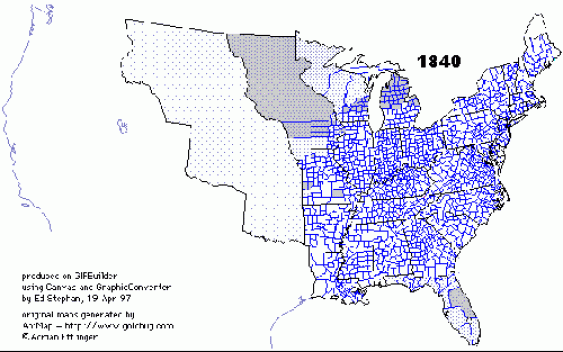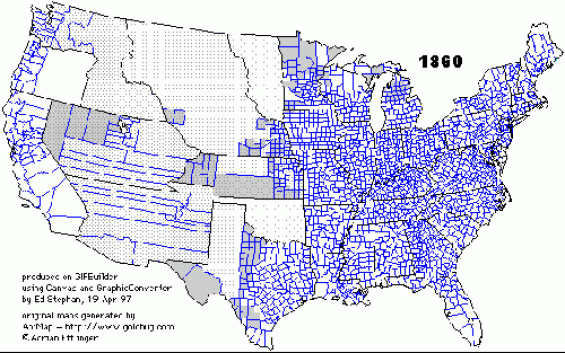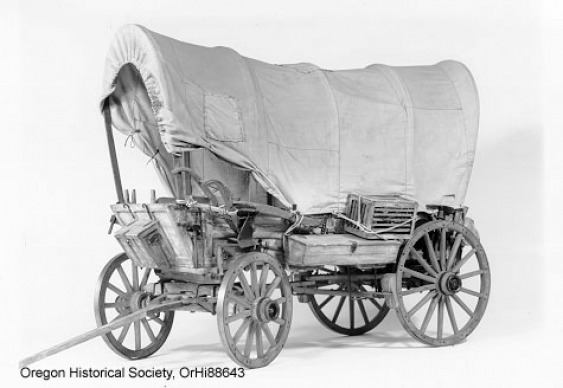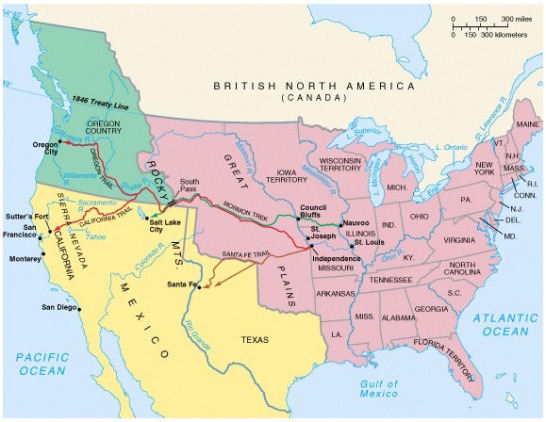Starting the Journey
Overview:
- Read another chapter of the book
- Population maps 1830’s to 1860’s
- Why did people decide to leave for the west?
Activity: “Do we go or do we stay?”
- Starting the Journey
Map of the Oregon Trail
Activity: Animals: Pros and Cons Race
Materials:
- Westward to Home: Joshua's Oregon Trail Diary
- Population maps on transparencies
- 2 “Do we go or do we stay?” worksheets for each student
- Oregon Trail transparency
- Wagon picture transparency
- 3 “Animals: Pros and Cons” papers
- Interactive Notebooks
Procedures:
Read around twenty pages in the book Westward to Home: Joshua's Oregon Trail Diary.
Show the maps to the class that show that in the 1830’s Americans only lived on the east side of the Unites States. Then show the maps that show how the American population expanded to the west in the 1840’s, 1850’s and 1860’s.
Why did people decide to go on the Oregon Trail:
Hold a class discussion on why they think some Americans decided to move to the west.
Tell the students the main reasons why some Americans left for the west:
-Free land was available.
-Freedom from slavery attracted many people.
-Good land for farming meant more and better crops.
-Good businesses could be made at forts.
-People wanted to control and populate new parts of the country
-Men and women had hopes and dreams for a growing nation.
-Heartache and hardship made people look for a new start.
-Some families were looking for a place to call home.
-Movement and change was desired by some travelers.
-Emigrants searched for opportunity.
-People were hurrying to obtain gold that had been discovered.
Pass out the two “Do we go or do we stay?” worksheets that asks students to write about whether or not they think there family would have moved to the west. Have student paste the worksheets in their INB and then complete them in class.
Starting the Journey:
Explain to the class the following:
Most families had to sell almost all of their belongings including their house, because they could not take very much with them on their journey.
Most pioneers met in Independence, Missouri to being the Oregon Trail. Families would load up their wagons with food and wait for the weather to warm and the grass to grow. (Show the map of the Oregon Trail)
In 1843 a group of 1,000 pioneers left Independence, Missouri for Oregon. In the twenty five years after that, hundreds of thousands of travelers followed the same trail.
Ask the class if they can think of the reason why people stopped using the Oregon Trail in the late 1860’s. (Railroads)
Show a transparency of the Oregon Trail.
Show a transparency of the type of wagon that the pioneers used for their journey
Tell the class that there were three options of animals that the pioneers had to pull their wagon.
Horses- fast, strong, can’t live off of just grass, very bothered by bugs
Oxen- survived on prairie grass, strong, calm, very slow
Mules- strong and fast, can survive on grass, very difficult to control
Break the class into three groups. Give each group a paper that explains the pros and cons of bringing one of the three animals on the journey to the west. Go outside and mark a start and finish line. Explain to each group that they must act as the paper described the animal. The Oxen group should win.
ESOL Accommodations: Class discussions will help build ESOL student's schema. Help them individually with the worksheets. Make sure someone helps them understand the animal race.
Sources:
Population Maps: http://franklaughter.tripod.com/cgi-bin/growth/1830.html
Information and Worksheets: www.blm.gov/or/oregontrail/education-teachers-packets.php
Wagon Picture: www.ci.tumwater.wa.us/Research%20Center/wagon.jpg
Oregon Trail Map: www.irwinator.com/126/w40.jpg




